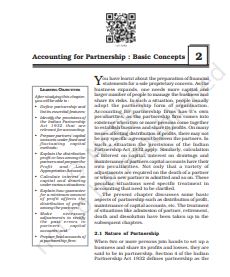‘NCERT Solutions for Class 12 Accountancy Chapter 2‘ PDF Quick download link is given at the bottom of this article. You can see the PDF demo, size of the PDF, page numbers, and direct download Free PDF of ‘Ncert Class 12 Accountancy Chapter 2 Exercise Solution’ using the download button.
NCERT Class 12 Accountancy Textbook Chapter 2 With Answer PDF Free Download

Chapter 2: Accounting For Partnership: Basic Concepts
You have learned about the preparation of financial statements for a sole proprietary concern.
As the business expands, one needs more capital and a larger number of people to manage the business and share its risks.
In such a situation, people usually adopt the partnership form of organization.
Accounting for partnership firms has its own peculiarities, as the partnership firm comes into
existence when two or more persons come together to establish a business and share its profits.
On many issues affecting the distribution of profits, there may not be any specific agreement between the partners. In such a situation the provisions of the Indian Partnership Act 1932 apply.
Similarly, calculation of interest on capital, interest on drawings, and maintenance of partners’ capital accounts have their own peculiarities.
Not only that a variety of adjustments are required on the death of a partner or when a new partner is admitted and so on.
These peculiar situations need specific treatment in accounting that need to be clarified.
The present chapter discusses some basic aspects of partnership such as the distribution of profit,
maintenance of capital accounts, etc.
The treatment of situations like the admission of a partner, retirement, death, and dissolution has been taken up in the subsequent chapters.
2.1 Nature of Partnership
When two or more persons join hands to set up a business and share its profits and losses, they are said to be in partnership.
Section 4 of the Indian Partnership Act 1932 defines partnership as the ‘relation between persons who have agreed to share the profits of a business carried on by all or any of them acting for all.
Persons who have entered into a partnership with one another are individually called ‘partners’ and collectively called ‘firms’.
The name under which the business is carried is called the ‘firm’s name’. A partnership firm has no separate legal entity, apart from the partners constituting it.
| Author | NCERT |
| Language | English |
| No. of Pages | 47 |
| PDF Size | 3.1 MB |
| Category | Accountancy |
| Source/Credits | ncert.nic.in |
NCERT Solutions Class 12 Accountancy Chapter 2 Accounting For Partnership: Basic Concepts
1. Define Partnership Deed.
A partnership deed also referred to as a partnership agreement, is a document of importance that contains the details of all the rights and responsibilities of the concerned parties involved in a business.
It helps in preventing any kind of disputes or disagreements that can arise between partners over their role in the business and the associated benefits from the partnership in the firm.
2. Why it is considered desirable to make the partnership agreement in writing.
According to the Partnership Act, 1932, having a Partnership deed in writing is not mandatory.
However, it is a safe option to have it in writing as it helps avoid any kind of disputes that may arise between partners of a firm in the future.
It also helps resolution of any kind of dispute as a written partnership that is signed by all the partners is suitable for use as evidence in a court of law.
3. List the items which may be debited or credited in the capital accounts of the partners when:
(i) Capitals are fixed
(ii) Capitals are fluctuating
(i) These items get credited:
1. Opening capital balance
2. Additional capital or Fresh capital that is added to the business.
These items get debited:
1. Part of capital that is withdrawn.
2. Closing capital balance
(ii)These items get debited
1. Opening capital balance
2. Fresh capital added in the accounting period
3. Salaries paid to partners
4. Profit share
5. Interest received on capital
These items get debited:
1. Withdrawals are done during the accounting year.
2. Interest accumulated on withdrawals (drawing)
3. Closing capital balance
4. Loss on shares
4. Why is the Profit and Loss Adjustment Account prepared? Explain.
It is prepared for the following reasons:
1. For recording transactions, errors, or omissions that may be left while preparing the final accounts.
2. To act as an account for distributing profit and loss between partners
3. To accommodate for changes in the partnership deed.
5. Give two circumstances under which the fixed capitals of partners may change.
Following circumstances lead to change in fixed capital of partners
1. Introducing fresh capital in the firm by a partner with consent from other partners.
2. When a portion of capital is withdrawn with the consent of partners.
Accounting For Partnership: Basic Concepts NCERT Textbook With Solutions PDF Free Download
